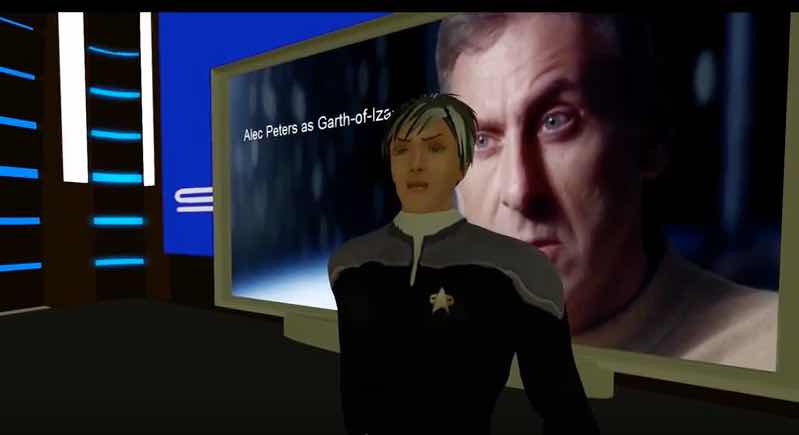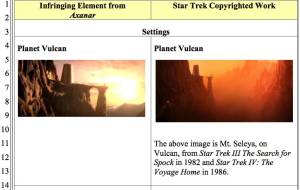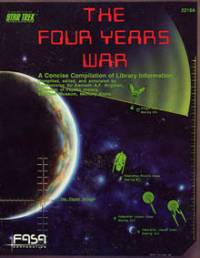
FROSTED TIPS Axanar producer Alec Peters answers questions in Second Life using an avatar in Next Generation-era garb and a hairstyle featuring frosted tips.
Axanar Aiming for Appeals Court Victory
Are Defense Lawyers Assuming a Loss Before District Judge Klausner?
Table of Contents
While preparing for his copyright infringement trial, Alec Peters told attendees of a virtual scifi conference his lawyers are already aiming for an appellate court victory, and that he is prepared to transform the format of Axanar to make it fall within copyright’s fair use boundaries.
Questions and Answers
Peters’ Q&A session at the Second Life event was recorded September 8, 2016, the 50th anniversary of Star Trek’s debut on network television.
« Even if we were to lose at trial, an appeal would likely be very positive for us. » — Alec Peters, Axanar producer
Precedent-Setting Case
Given his attorneys’ defense against infringement based on fair use, Peters described the case as “absolutely … precedent-setting,” and watched closely in Hollywood. Interestingly, he spoke little of the actual case as it is being prepared for trial — raising doubt about what he believes of the defense’s chances before federal district court Judge R. Gary Klausner and went straight to describing the appeals process:
This case is being held in Southern California, and if it gets appealed it’ll get appealed to the Ninth Circuit – one of the most liberal circuits in the country, and pro-artists’ rights. Even if we were to lose at trial, an appeal would likely be very positive for us.1)
 What is Second Life?
What is Second Life?
Second Life is an online, three-dimensional virtual world developed by a San Francisco-based company that provides space for users (called Residents) to create visual representations of themselves (avatars) that can interact with other residents, places or objects.
The event in which Peters appeared for a virtual question-and-answer session was the “Trek for a Cure” Faire, sponsored by the Sci-Fi Alliance. The Faire, held September 7-11, 2016, celebrated the 50th anniversary of Star Trek, and raised money for the American Cancer Society.2)
See also: Copyright and Fair Use Cases in the U.S. Court of Appeals for the Ninth Circuit (Stanford University)
That interpretation of the Ninth Circuit Court of Appeals’ treatment of copyright infringement cases struck some legal observers as optimistic, given that its rulings are overturned by the U.S. Supreme Court more than 80 percent of the time — the greatest of any of the circuit courts.
Killing Fan Films
Several of the questions centered on CBS and Paramount’s new fan production guidelines. Peters described the studios’ intentions like this: “They decided to do whatever they could to eliminate fan films.” Most fan films have actually adapted to work within the guidelines.
Fair Use
One questioner asked how Axanar could be sued if it was being produced without intending to profit. Peters replied that making money had no bearing on whether infringement occurred, explaining that Axanar’s defense was based on fair use, which protects “new and unique” uses of copyrighted material. He explained the fair use four-factor test used by courts like this:
- What is purpose and character of the use, including whether the use is of a commercial nature or of nonprofit or educational purposes?
- What is the nature of the use, such as whether it is transformative, like parody or scholarship?
- What amount of the original work used? Peters claimed Axanar “uses a very, very tiny portion of the copyrighted work of Star Trek.”
- What is the effect of the use on the potential market for or value of the copyrighted work?
Of the four factors, Peters assessed Axanar against only the third, stating Axanar infringed upon only a “tiny portion” of Star Trek, a claim disputed by the legal complaint against Peters. And he avoided any discussion of the fourth factor — commercial impact — an area in which many legal observers believe Axanar’s case is the weakest.
Side-by-Side Comparisons
The legal complaint spent 28 pages detailing alleged copyright infringements by running side-by-side comparisons of copyrighted Star Trek elements copied by Axanar, including specific characters, alien species and their specific appearances, uniforms and costumes, command insignia and medals, planets and other settings, space docks, Federation, Vulcan and Klingon starships, logos, governmental details, stardates, futuristic technology, fictional languages and philosophies and architecture.3)
The lawsuit noted Axanar took even more copyrighted elements, and that Peters intended Prelude to Axanar and Axanar to be prequels to the Original series, making them unauthorized derivative works, unlicensed by either CBS or Paramount.4)
Transforming 'Axanar'
Asked how the outcome of the lawsuit might affect Axanar, Peters confirmed rumors that he and director Robert Meyer Burnett may change the way they tell the story of Garth of Izar and the Battle of Axanar:
One of the things we’re hoping to do is make more episodes of The Four Years War, which is the documentary series that we made Prelude to Axanar in. … It’s quite possible we’ll take the movie script and make it in the four episodes of The Four Years War.
Prelude styled itself as “Part III” of a mockumentary, The Four Years War, telling the story of a non-canon conflict between the Federation and the Klingon Empire. Peters took that concept of the war from a Paramount-licensed role-playing game published by FASA from 1982-1989.
Peters and Burnett have previously floated the idea that, produced as a fictional documentary, Axanar would be sufficiently transformative to claim fair use under copyright law, a defense for producing what would otherwise be an unauthorized derivative work.
The Quality Argument
The moderator repeated the often-heard but inaccurate notion that CBS and Paramount sued Axanar because it was too good, and asked Peters if that was true. Peters replied that Axanar itself had yet to be produced but that he was proud of the production values in Prelude and in the two-minute “Vulcan Scene” from the Axanar screenplay that he released in 2015 to promote his Indiegogo campaign:
Understand, of course, that we haven’t made Axanar yet. … We’re very proud of [the Vulcan Scene], which is available online.5)

Peters neglected to mention, however, that after the lawsuit was filed in December 2015, he removed the Vulcan Scene from the Indiegogo campaign page, and issued multiple copyright takedown notices for copies other people had uploaded to YouTube, Facebook, Vimeo and other video sites.
The only publicly available copy of the Vulcan Scene is posted on YouTube by a user who successfully appealed Axanar’s takedown notice.
Further Fundraising
One questioner wondered whether Peters needed to use any of its donors’ money to pay for its legal costs. Peters replied that Axanar’s law firm, Winston & Strawn, was representing him pro bono, covering all the lawyers’ fees. That arrangement does not include costs apart from attorneys’ time. Those costs may be covered by yet another crowdfunding campaign, Peters said:
At some point I’m sure there will be a fundraiser just for incidental costs.6)
Peters also encouraged one supporter to give him money using the Axanar website’s Donate button, even though the questioner specifically asked how to lend non-monetary support to the project.
Casting 'Prelude'
Peters described how he cast so many well-known scifi actors in Prelude to Axanar, starting with Richard Hatch (Battlestar Galactica), who is Peters’ acting coach. Hatch introduced him to J.G. Hertzler (Star Trek: Deep Space Nine), whom Peters described as “an easy get.” Successful meetings later brought Kate Vernon (Battlestar Galactica) and Tony Todd (Star Trek: Deep Space Nine) aboard.
Todd, of course, dropped the project a year before amid public concerns about Peters’ production delays and lack of accountability for his $1.1 million crowdfunded budget.
Future Projects
Prevented from producing Axanar, Peters told attendees he had “four or five different projects we’re working on,” mostly with new directors. He mentioned:
- One project with “a rather famous science fiction writer whom you all know.” Curiously, he did not mention David Gerrold by name, even though he had repeatedly discussed the project before.
- “The Battle for Axanar,” a documentary about the controversy surrounding the making of Axanar, including the copyright infringement lawsuit Peters is facing by Star Trek’s owners, CBS and Paramount Pictures.

Keywords



